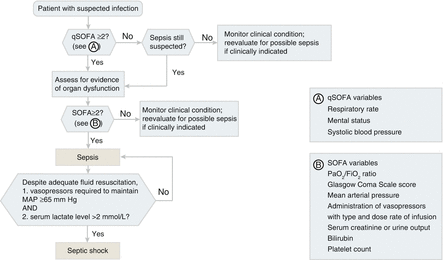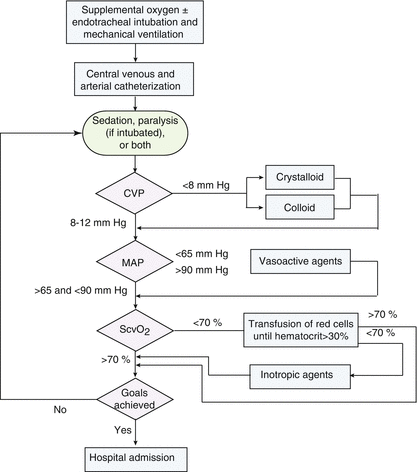Infection
Inflammatory response to the presence of microorganisms or the invasion of those microorganisms into a host
Bacteremia
Presence of viable bacteria in the blood
Systemic infammatory response syndrome (SIRS)
The systemic inflammatory response to clinical insults and must meet ≥2 of the following
Temp >38 °C or <36 °C
Heart rate >90 beats/min
Resp rate > 20 breaths/min or PaCO2 < 32 torr (<4.3 kPa)
WBC > 12,000 cells/mm3, <4,000 cells/mm3, or >10 % bands
Severe sepsis
Sepsis associated with organ dysfunction, hypoperfusion, or hypotension
Septic shock
Sepsis with hypotension, despite adequate fluid resuscitation and presence of perfusion abnormalities (i.e., lactic acidosis, elevated base deficit, etc.)
Hypotension
Systolic BP < 90 mmHg
Multiple organ dysfunction syndrome
Presence of altered organ function in an acutely ill patient such that homeostasis cannot be maintained without intervention
16.2.1 Third International Consensus Definitions for Sepsis and Septic Shock (Sepsis-3)
The definitions of sepsis and septic shock have been revised in 1991 and 2001. Despite considerable recent advances in the pathophysiology of sepsis, the epidemiology and management of sepsis remain hampered by an inadequate sensitivity and specificity of the SIRS criteria, and the limitations of having multiple unclear definitions for sepsis, septic shock, and organ dysfunction.
The Third International Consensus Definitions for Sepsis and Septic Shock (Sepsis-3) proposed at the 2016 45th Annual Meeting of the Society of Critical Care Medicine (SCCM) includes updated definitions for sepsis and septic shock, as summarized in Fig. 16.1 [5].


Fig. 16.1
Operationalization of clinical criteria identifying patients with sepsis and septic shock. The baseline Sequential [Sepsis-related] Organ Failure Assessment (SOFA) score should be assumed to be zero unless the patient is known to have preexisting (acute or chronic) organ dysfunction before the onset of infection. qSOFA indicates quick SOFA, MAP mean arterial pressure (From Singer et al. [5])
Sepsis is further defined as a life-threatening organ dysfunction caused by a dysregulated host response to infection. Organ dysfunction can be represented by an increase in the Sequential [Sepsis-Related] Organ Failure Assessment (SOFA) score of 2 points or more, which is associated with a higher risk of in-hospital mortality. These SOFA scores for major organ system are detailed in Table 16.2 [5].
Table 16.2
Sequential [Sepsis-Related] Organ Failure Assessment score
System | Score | ||||
|---|---|---|---|---|---|
0 | 1 | 2 | 3 | 4 | |
Respiration | |||||
Pao2/Fio2, mmHg (kPa) | ≥400 (53.3) | <400 (53.3) | <300 (40) | <200 (26.7) with respiratory support | <100 (13.3) with respiratory support |
Coagulation | |||||
Platelets, ×103/μL | ≥150 | <150 | <100 | <50 | <20 |
Liver | |||||
Bilirubin, mg/dL (μmol/L) | <1.2 (20) | 1.2–1.9 (20–32) | 2.0–5.9 (33–101) | 6.0–11.9 (102–204) | >12.0 (204) |
Cardiovascular | MAP ≥70 mmHg | MAP <70 mmHg | Dopamine <5 or dobutamine (any dose)a | Dopamine 5.1–15 or epinephrine ≤0.1 or norepinephrine ≤0.1a | Dopamine >15 or epinephrine >0.1 or norepinephrine >0.1a |
Central nervous system | |||||
Glasgow Coma Scale scoreb | 15 | 13–14 | 10–12 | 6–9 | <6 |
Renal | |||||
Creatinine, mg/dL (μmol/L) | <1.2 (110) | 1.2–1.9(110–170) | 2.0–3.4 (171–299) | 3.5–4.9 (300–440) | >5.0 (440) |
Urine output, mL/day | <500 | <200 | |||
Septic shock is defined as sepsis with particularly profound circulatory, cellular, and metabolic abnormalities that are associated with an even greater risk of in-hospital mortality. Patients with septic shock are clinically identified by a vasopressor requirement to maintain adequate hemodynamic and perfusion goals.
A new clinical score termed quickSOFA (qSOFA) is also proposed for adult patients outside of the intensive care unit (ICU) and with suspected infection. This score is largely based on tacchypnea, hypotension, and altered mentation, and is deemed a marker for poor outcomes [5].
16.3 Clinical Features and Diagnosis
The recognition of SIRS in a patient should prompt close monitoring for signs of development of sepsis and end organ dysfunction. Diagnosis of sepsis is dependent upon set criteria of signs, and more recently has been a subject of much debate.
16.3.1 Clinical Criteria Identifying Patients with Sepsis and Septic Shock
SIRS can manifest itself by the hallmark features of tachycardia, tachypnea, hyperthermia, and leukocytosis, among other traditionally accepted upon criteria outlined in Table 16.1 [3]. Where SIRS is presumed to be caused by a suspected or proven infection, the criteria for sepsis is considered to have been met.
It is vital to embark upon a search for rapid identification of a microbial cause as the source of infection. Patients should be promptly pan-cultured, with administration of broad-spectrum antimicrobial therapy in rapid succession. Even still, a microbial source is not clearly identified via cultures in up to one-third of sepsis cases [6]. Appropriate imaging modalities – including plain radiographs, computed tomography (CT), and ultrasound scans – should be utilized to search for the source of infection.
With worsening sepsis, hypoperfusion and hypotension may set in, leading to the development of end organ dysfunction. This rapidly deteriorating clinical state with persistent refractory hypotension despite adequate resuscitation is known as septic shock.
16.3.2 Sepsis-3 and SOFA Scores
According to the updated consensus definitions for sepsis and septic shock (Sepsis-3) proposed at the 45th Annual SCCM Meeting, sepsis is defined as a life-threatening organ dysfunction caused by a dysregulated host response to infection (see Fig. 16.1). Organ dysfunction is further defined by an increase in the SOFA score of 2 points or more (see Table 16.2).
Among ICU patients with suspected infection, SOFA scores signaling organ dysfunction are associated with a higher risk of in-hospital mortality, supporting its use in clinical criteria for sepsis [7].
16.3.3 Biomarkers of Sepsis
Identification of biomarkers for sepsis has been the topic of considerable research work. Despite a handful of biomarkers being proposed as possible markers of sepsis, at present time biomarkers are not routinely utilized for the diagnosis of sepsis, or to guide and assess response to therapy.
C-reactive protein (CRP) is a marker for generalized inflammation and it is markedly elevated in the setting of infection [8]. The persistence of elevated CRP levels past 36 h has been shown to be associated with worse outcomes in septic patients [9], while a decreasing CRP level over the first 48 h indicates effective antimicrobial therapy [10].
Generalized inflammation and infection also causes an elevation in the levels of procalcitonin (PCT). PCT assays have been shown to be a superior target biomarker than CRP in recent studies, with rising levels seen in worsening sepsis, and a decrease noted after institution of appropriate antimicrobial therapy [11–13]. A decreasing PCT level at day 3 of therapy has been associated with improved survival [14].
More recently, efforts are directed at identifying novel targets as biomarkers to differentiate SIRS from sepsis. Recent data suggest that one such target of measure is monocyte distribution width, where elevated monocyte distribution width in blood was shown to be a superior biomarker than any of the other volumetric cell parameters assessed in helping distinguish sepsis from uninfected patients with SIRS. For sepsis, the negative predictive value of normal monocyte distribution width was 98 % [15].
16.4 Management of Sepsis and Septic Shock
The Surviving Sepsis Campaign (SSC) has published clear guidelines for the treatment of sepsis and septic shock [16]. This has led to the development of sepsis bundles to streamline the application of therapy in many intensive care units, reducing morbidity, mortality, and health care costs associated with sepsis and septic shock [17–21]. Early recognition of signs of sepsis paired with prompt administration of appropriate therapy are cornerstones in reducing sepsis-associated mortality. The general principles of management of sepsis and septic shock include resuscitation, source control, monitoring, and supportive care.
16.4.1 Initial Resuscitation and Hemodynamic Support
In their seminal paper, Rivers et al. outline the endpoints of resuscitation that signal adequate tissue perfusion. Specific resuscitation parameters for MAP, CVP and ScvO2 are set forth as a goal to be achieved in the first 6 h of the onset of severe sepsis or septic shock (see Fig. 16.2) [22].









